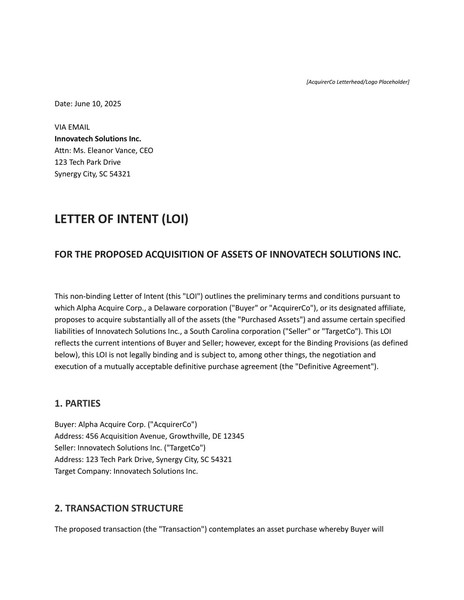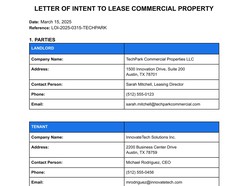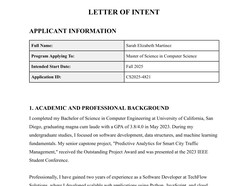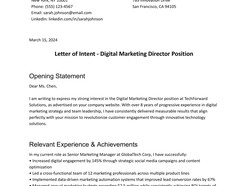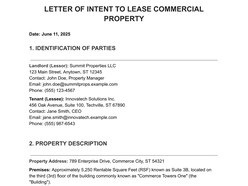This Letter of Intent (LOI) for Business Acquisition template provides a structured framework for outlining the principal terms of a prospective business purchase or merger. It is designed to facilitate clear communication and establish a mutual understanding between buyer and seller before committing to extensive due diligence and definitive legal agreements.
Features:
- Comprehensive Sections: Covers all critical areas including identification of parties, transaction structure, purchase price and consideration, key conditions to closing, and due diligence parameters.
- Binding & Non-Binding Clarity: Clearly distinguishes between non-binding expressions of intent and legally binding provisions such as exclusivity, confidentiality, and governing law.
- Professional Formatting: Incorporates modern document styling with clear headings, organized tables for financial terms and timelines, and appropriate emphasis for readability.
- Placeholder Content: Includes sample data and bracketed placeholders [like this] to guide customization for specific transaction details.
- Structured for M&A: Addresses common elements like working capital adjustments, employee considerations, and public announcement protocols.
Who is this template for?
This template is designed for:
- Business owners considering selling their company.
- Entrepreneurs or corporate entities looking to acquire a business.
- M&A advisors, brokers, and consultants assisting in transactions.
- Legal professionals seeking a foundational LOI document.
In what situations should it be used?
Utilize this document during the preliminary stages of a business acquisition process when:
- A serious buyer wishes to formally express interest to a seller.
- Both parties are ready to outline the fundamental terms of a potential deal.
- A roadmap for negotiation, due diligence, and the drafting of a definitive purchase agreement is required.
- An exclusivity period is sought by the buyer to conduct due diligence without competition.
Format: Google Docs
Contributed by: Olivia Davis
How To Use This Letter of Intent Template
Accessing and utilizing this Letter of Intent (LOI) template is straightforward, enabling a prompt start to outlining your business acquisition terms.
Getting Started:
Access the Template: Click the "Use template" button prominently displayed on this page.
Google Account Required: You will be prompted to sign in to your Google account. If you do not have one, a free account can be created.
Create Your Copy: Upon clicking, a new, editable copy of the LOI document will be automatically created in your Google Drive. This new document is yours to modify.
Customization Best Practices:
Replace Placeholders: Systematically review the document and replace all bracketed placeholder text (e.g., [AcquirerCo Name], [Purchase Price Amount], [Date]) with the specific details relevant to your transaction.
Adapt Terms: While comprehensive, tailor the terms—such as payment structure, earn-out conditions, or specific assets/liabilities—to accurately reflect the unique aspects of the intended deal.
Review Key Conditions: Pay close attention to the "Key Conditions to Closing." Ensure these conditions are appropriate and achievable for both parties involved.
Understand Binding Provisions: The sections designated as "Binding Provisions" (typically exclusivity, confidentiality, expenses, governing law) have legal implications even if the overall LOI is non-binding. Understand these commitments thoroughly.
Due Diligence Scope: Adjust the due diligence section to reflect the anticipated depth and timeframe required for your investigation.
Timelines: Modify the indicative timeline to set realistic expectations for all parties.
Important Considerations:
Not Legal Advice: This template provides a general structure and common terms. It is not a substitute for professional legal counsel. Every transaction has unique legal and financial considerations.
Consult Professionals: It is strongly recommended that both buyer and seller consult with their respective legal and financial advisors before signing this or any LOI. They can help tailor the document and explain the implications of each term.
Clarity is Key: Ensure all terms are expressed clearly and unambiguously to prevent misunderstandings later in the process.
Exclusivity Impact: If an exclusivity (no-shop) clause is included, the seller should fully understand its restrictions on entertaining other offers during the specified period.
